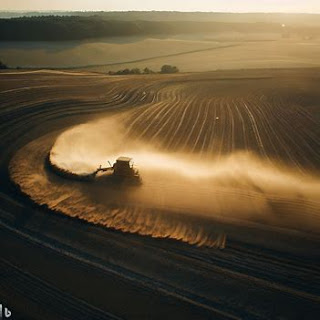Search This Blog
An Environmental website whose primary focus is to help everyone understand the impact humans have on the physical environment with resources that help us achieve what we call a safe and clean environment.
Featured
- Get link
- X
- Other Apps
Conservation Agriculture: Transforming the World through Technological Innovation
Introduction:
In a world grappling with the challenges of climate change and its far-reaching impacts, the need for sustainable agricultural practices has never been more critical. Conservation Agriculture (CA) emerges as a technological solution that not only addresses the environmental concerns associated with conventional farming but also paves the way for a resilient and food-secure future. By implementing CA techniques, farmers can cultivate their lands more sustainably, mitigate climate change, and adapt to its effects, ultimately contributing to the betterment of our planet.
Understanding Conservation AgricultureConservation Agriculture is a holistic approach that emphasizes three key principles: minimal soil disturbance, permanent soil cover, and diverse crop rotations. Unlike conventional methods that rely on intensive tillage, chemical inputs, and mono-cropping, CA promotes the use of modern technologies
Soil degradation is a pressing concern exacerbated by climate change. Intensive plowing and excessive use of chemicals can lead to erosion, nutrient depletion, and loss of soil organic matter. Conservation Agriculture advocates for reduced soil disturbance through techniques like no-till or minimum tillage, preventing erosion, improving soil structure, and promoting water retention. By nurturing healthy soils, CA enables more resilient farming systems capable of withstanding extreme weather events associated with climate change.
Enhancing Water Management
Water scarcity and erratic rainfall patterns pose significant challenges for agriculture in the face of climate change. Conservation Agriculture practices such as retaining crop residues on the soil surface act as natural mulch, reducing evaporation and maintaining soil moisture levels. This method helps combat drought conditions and improves water-use efficiency, enabling farmers to cultivate crops successfully in water-stressed regions.
Mitigating Greenhouse Gas Emissions
Conventional agriculture is a significant contributor to greenhouse gas emissions, primarily through carbon dioxide released during tilling and nitrous oxide emissions from synthetic fertilizers. Conservation Agriculture offers an effective solution to mitigate these emissions by minimizing soil disturbance and adopting precision nutrient management practices. Additionally, CA practices promote the sequestration of carbon in the soil, helping to offset the carbon footprint of agriculture and combat climate change.
Promoting Biodiversity and Ecosystem Services
Conservation Agriculture fosters biodiversity by encouraging diverse crop rotations and maintaining natural habitats within agricultural landscapes. This approach promotes beneficial organisms like pollinators, predators, and soil microbes, which contribute to pest control, nutrient cycling, and overall ecosystem resilience. By embracing CA, farmers play a vital role in preserving biodiversity and supporting the natural processes that underpin agricultural productivity.Increasing Resilience and Food Security:
Climate change poses significant threats to global food security. Extreme weather events, shifting precipitation patterns, and increased pest pressures all jeopardize crop yields and livelihoods. Conservation Agriculture empowers farmers to adapt and build resilience in the face of such challenges. By enhancing soil health, conserving water, and promoting diversified cropping systems, CA helps ensure consistent yields, reducing vulnerability to climate-related risks and ensuring a more secure food supply.
Conclusion
Conservation Agriculture stands as a transformative technological solution that enables farmers to mitigate and adapt to climate change while ensuring sustainable food production. By embracing CA practices, we can protect and enhance our natural resources, reduce greenhouse gas emissions, foster biodiversity, and build resilient farming systems. As we collectively navigate the challenges of a changing climate, Conservation Agriculture paves the way for a future where sustainable and productive agriculture coexist, providing a foundation for a healthier planet and a more secure future.
- Get link
- X
- Other Apps
Popular Posts
Environmentally Persistent Pharmaceutical Pollutants (EPPPs): A Growing Threat to Our Ecosystems
- Get link
- X
- Other Apps
Blue Ammonia: A Sustainable Energy Solution in Comparison
- Get link
- X
- Other Apps





Comments
Post a Comment